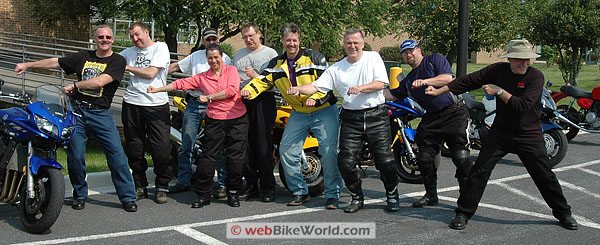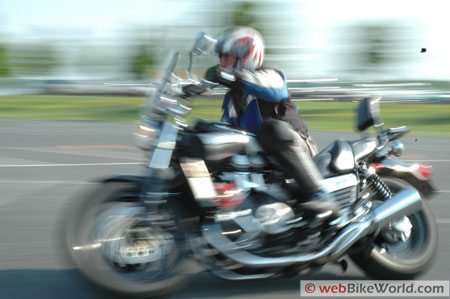Total Control Advanced Riding Clinic
My “Aha!” moment came about half-way through the afternoon cornering exercises.
I was fighting the Ducati around the tight oval, trying not to flatten the cones while wrestling for control of the handlebars.
It felt like a cage match with The Great Khali, and I suddenly realized that I didn’t know as much as I thought.
Wasn’t it just yesterday that I smugly considered myself Mr. Smooth, thinking that only Nimrods would learn anything from riding around in a parking lot?
It’s not easy to overcome the ego that motorcycle riders develop with experience.
That ego creates an immediate skepticism for anything presented in a classroom, with mutterings of “It’s all theory” and “I know better”.
But something from the morning class kept bouncing back and forth across the synapses of my little gray cells.
“Relax and the bike will do the rest” — yes, that was it! I could relate to this Zen-like concept, and since the decades of experience weren’t helping very much, it was worth a try.
The inner voice finally talked my hands out of their death grip. I relaxed everything north of my hips.
And guess what? Lo and behold, the bike waltzed around the tight corners, just like they said.
Next time, I’ll pay closer attention in class…
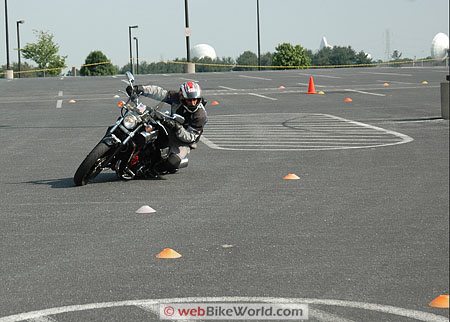
The Total Control Riding Clinic
The Total Control clinic has many things to offer, but the moment that I learned to relax my body stands out as a dramatic reason why there’s no such thing as too much training when it comes to motorcycle riding.
I had never realized how much I was fighting the bike — a bad habit that was probably caused by some deeply rooted fear.
Maybe it was fear of the unknown — after all, we motorcyclists don’t often get the opportunity for guided riding sessions at the limit; the limit, that is, of our machines and our minds.
That experience helps populate the rider’s database with the do’s and don’ts which are then used to make the riding experience safer and more enjoyable.
It’s actually rather embarrassing to think you know a thing or two or more about riding a motorcycle, only to find yourself flummoxed by a couple of 40-foot circles pasted to a college campus parking lot.
But that’s what it’s all about, and the Total Control instructors provide plenty of feedback — in private, thank you — to help each student become a better and, hopefully, a safer rider.
Lee Parks started the Total Control motorcycle training courses after discovering the huge pent-up demand for more advanced knowledge subsequent to the release of his book “Total Control: High-Performance Street Riding Techniques” (review).
The book, first published in 2003, has become the #2 best-selling motorcycle riding instruction book in the U.S.A., second only to David Hough’s classic “Proficient Motorcycling” (review).
MSF Experienced Rider Course vs. Total Control Clinic?
The Total Control Advanced Riding Clinics are designed to be a bridge between the Motorcycle Safety Foundation’s Experienced Rider Course (review) and a track day.
I’ve taken both the MSF Basic Rider Course (review) and the ERC, and the Total Control clinic is a logical next step that builds on a rider’s MSF knowledge.
I’m actually scheduled to take the ERC again in June, motivated by the discount offered by my motorcycle insurance provider. It’s been over 5 years since I last took the ERC, and surely the course has been updated by now. So this will be a fresh opportunity to compare the two.
Just by coincidence, an ERC course was taking place on the other side of the parking lot during our Total Control clinic.
I caught the riders staring at us over the fence on more than one occasion — was that jealousy I detected in their eyes?
After all, while we were having loads of fun learning how to scrape metal parts from the nether regions across the parking lot, they were plowing through what appeared to be some pretty tame exercises in comparison.
Don’t get me wrong — I’m a big believer in MSF training. I’d been riding for 20+ years before I took the beginner course in Florida as a fast-track method to a Class M license after moving there.
That course made me quickly realize how much I didn’t know about motorcycling for the past two decades. How I ever survived is beyond me… I’ve tried to take at least one advanced motorcycle training course each year ever since.
The Total Control clinics aren’t affiliated with MSF and, unfortunately, insurance companies don’t offer a discount for successful completion.
But they should, because the Total Control format provides way more than the ERC, with about a third of the day in the classroom and the rest of the time spent out on the range, practicing what’s preached.
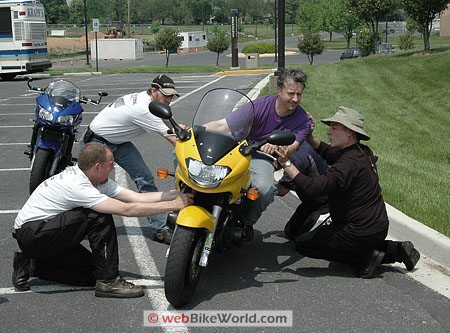
Total Control Clinic Agenda
The class time is focused on understanding the physics of riding and motorcycle dynamics.
The knowledge gained is used as a foundation for the riding exercises, which build on each other and culminate in the tight Figure 8 riding course at the end of the day.
Lesson 1 starts in the classroom with “The 6 Keys to Cornering”.
Then the day progresses with both class and range time covering topics such as throttle control, throttle to brake transitions (another eye-opener for me).
Also, you’ll get lots of advice on the mental aspects of motorcycling (more important than you might think and an important factor for much of the rest of the day).
And finally, suspension theory and practice and its relation to riding dynamics.
The training continues with topics including body positioning; envisioning; throttle control; throttle and brake transitions and more.
Range Exercises
The range exercises always start with a demonstration by the instructor and narration by the assistant instructor, clearly illustrating the “wrong” way to ride the lesson followed by the correct technique.
We started with throttle transitions, which taught us how to smoothly decelerate while using both the throttle and front brake at the same time.
This is something that was anathema in the Experienced Rider Course, where the riders are instructed to keep four fingers on the throttle or brake, but not at the same time!
The concept builds on the classroom discussion of motorcycle dynamics and how abrupt transitions can upset the balance of the bike and can be dangerous, especially in wet or unstable conditions.
It was another learning moment for me — I thought rolling off and on the throttle was good enough, never realizing how much I was chopping the throttle on deceleration, which can completely change the attitude of the bike and not always to good effect.
We had just 7 students in the class, all on a variety of motorcycles, from a Harley Sportster to a Honda Sport bike.
The class was divided into two groups between the instructors, which provided more than adequate time for individual detailed critiques after each run.
Class Format
The format works well, although I would have preferred a bit more time for practicing each exercise. Each rider travels two times around the cones and there are three tries for each exercise.
But I think that the more complex exercises need at least one ride around for the student to get settled on the bike, sight the course and then remember what he or she is supposed to accomplish.
With only two laps, it’s sometimes difficult to master the lesson before it’s time to pull off to the side, get critiqued and wait for the others to complete their turn.
Each student does get to do this three times for each exercise, but I’d prefer a concentrated 3-4 laps on each circuit to help develop the skills.
A possible solution might allow each rider go around maybe four times, with the entire group providing the critique?
This would allow each student more time to get settled in and practice all of the moves, while the students on the sideline could watch and learn from everyone’s mistakes.
The course also stresses knowledge of the physical aspects of the bike and this is reinforced with the exercises on the range.
Smooth riding techniques help to keep the motorcycle settled, which allows better, smoother, safer and, ultimately, faster riding (on the track, of course!).
Classroom vs. “Track” Time
The last classroom session in the late afternoon is a mini-course in suspension setup and knowledge. I’ll admit I was running out of steam by then, and although some of the students really enjoyed the session, I was ready for more range time.
I wonder if it would be possible to divide the students into two groups, with a choice of either the suspension class or some free practice time on the range with one of the instructors.
However, there was some free time at the end of the day available for students to either practice their skills on the range or have their suspension sag checked; unfortunately by that time I was ready to peel off my sweaty leathers and call it a day.
But these are nitpicks; overall, the Total Control Advanced Riding Clinic was an excellent learning adventure, taught by highly skilled, knowledgeable (and patient!) instructors.
We had a wonderful group of students, each on a completely different type of motorcycle, and the camaraderie made for loads of fun and we learned a great deal from each other too.
You owe it to yourself to learn as much as possible about motorcycle riding, and the Total Control Advanced Riding Clinic is the perfect next step after the MSF Experienced Rider Course.
For more information, check the Total Control website for a clinic near you.
Editor’s Note: This Total Control training class was provided free of charge to webBikeWorld for evaluation purposes but with no other agreement implied or otherwise as to the outcome of this article.
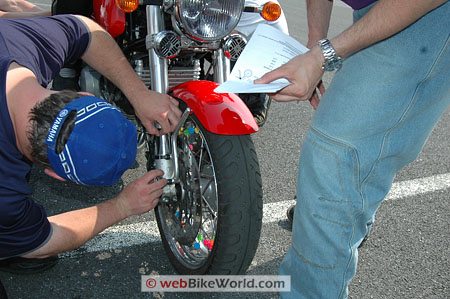
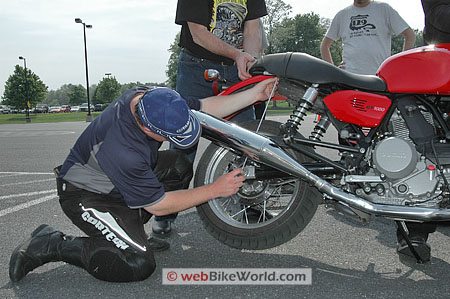
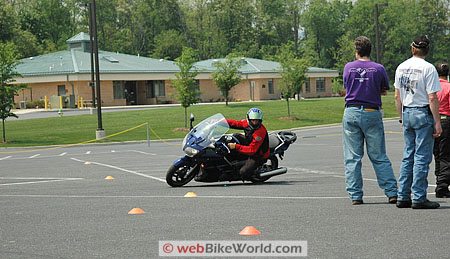
About the Instructors
Tracy Martin has been teaching the Total Control Advanced Riding Clinic since 1998 and was one of one of Lee Park’s original instructors.
He has been instrumental in developing the current curriculum and trains Total Control instructors through out the U.S.A. Tracy contributed to the book Total Control: High-Performance Street Riding Techniques” (review), by Lee Parks.
Tracy is currently is an author and moto-journalist and writes for Motorcycle Consumer News, RoadBike, Iron Horse and Friction Zone magazines.
In addition to enthusiast magazines, Tracy writes a monthly column entitled “Service Speak” for Motorcycle Product News, a monthly power sports trade magazine.
Motorbooks International has recently published Tracy’s book entitled “Motorcycle Electrical Systems Troubleshooting and Repair” (review).
Looking For More?
Be sure to visit the wBW Motorcycle Training and Track Days page, the Motorcycle Book Reviewspage and our Motorcycle Videos page for more information on how you can improve your motorcycle riding skills.
Publication Date: May 2007
Master Listing of All wBW Motorcycle Product Reviews
Owner Comments and Feedback
See details on submitting comments.
From “L.R.B.” (May 2012): “I recently had the opportunity to attend a “Jason Pridmore Star Motorcycle School” National Guard Training day at Thunderhill Raceway in California.
In the 40 years I have been riding this is by far the best and most useful training I have ever received.
The event is sponsored by the Army National Guard but is open to Air National Guard members if not filled by Army first. The class focuses on learning essential control techniques and practicing those techniques in a controlled environment.
The knowledge and skills gained during this training are essential to reducing the rising numbers of military members injured or killed in motorcycle accidents, especially the accidents due to Loss of Control (LOC).
Jason Pridmore is a consummate professional with an impressive pedigree and he is dedicated to providing training to military members which will help prevent these injuries and save lives.
The Air Force should follow the Army example and sponsor training such as the Star motorcycle school, I believe the training will save lives.”
From “J.F.”: “It’s nice to know that I wasn’t the only one with the “death grip” syndrome that the class helped to overcome. I now catch myself saying out loud as I enter a turn: “push forward more, I can handle it”.
Dave and Tracy were great. It was money well spent.
Having read the book, I found the class gave the lessons and advice in the book more personal relevance. For example, I had glossed over the chapter on suspension. Now that chapter has more significance.”


